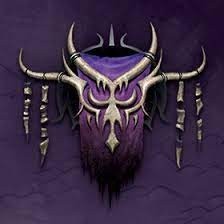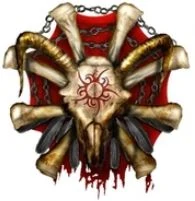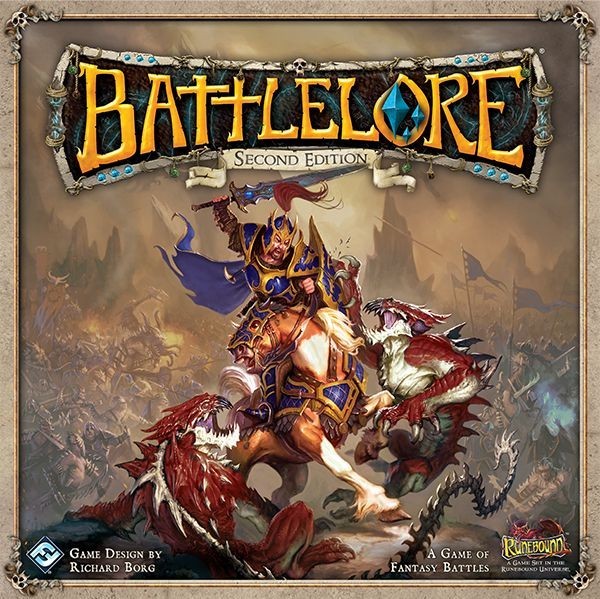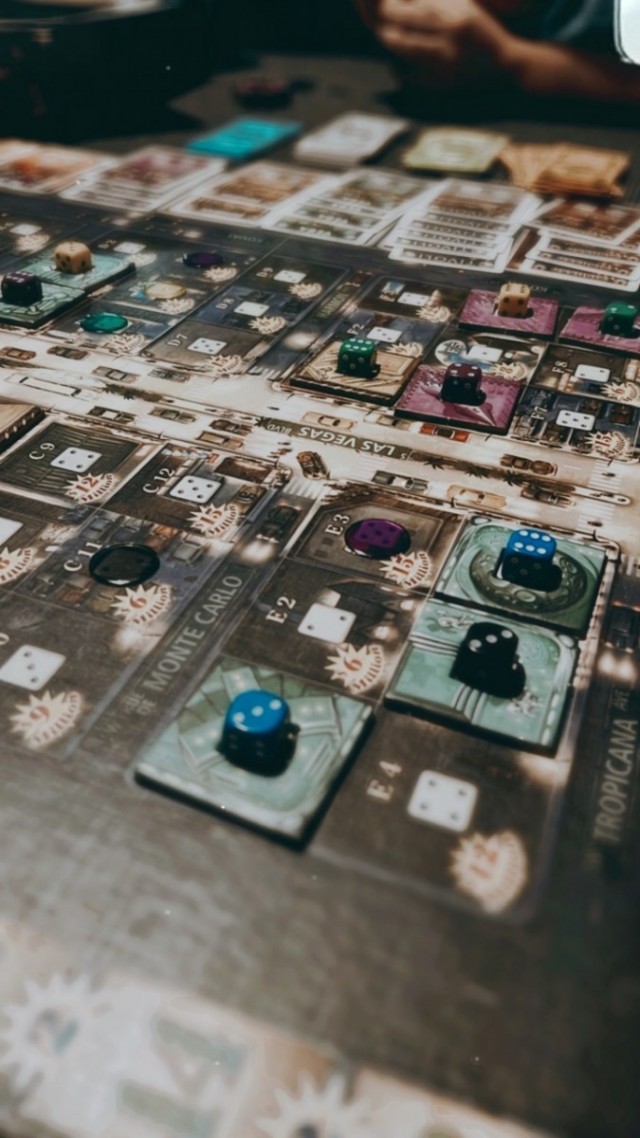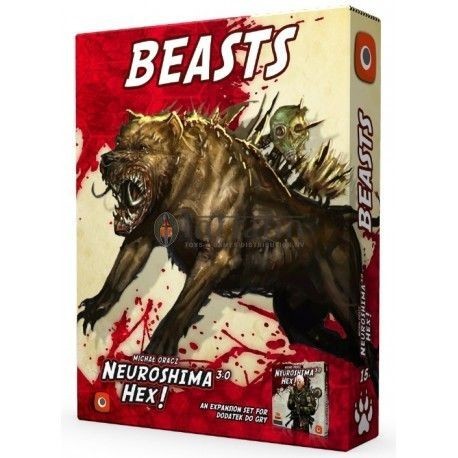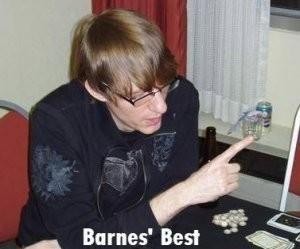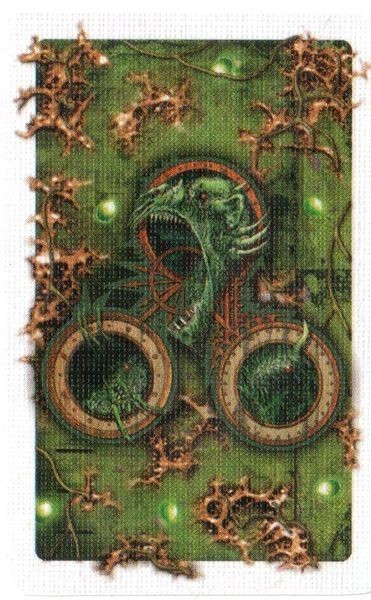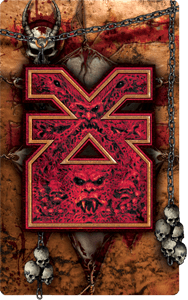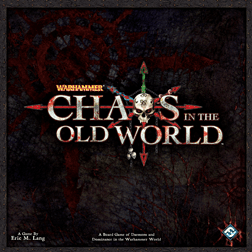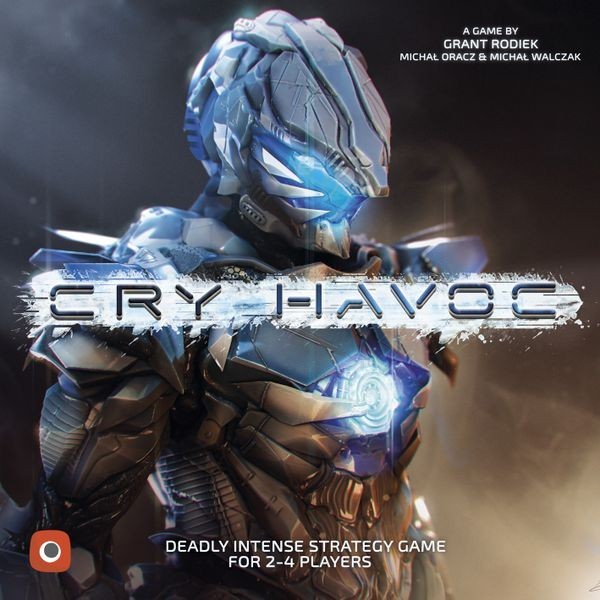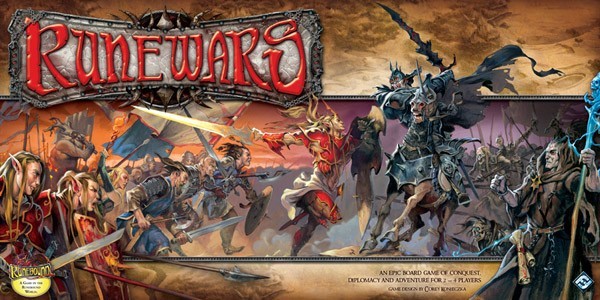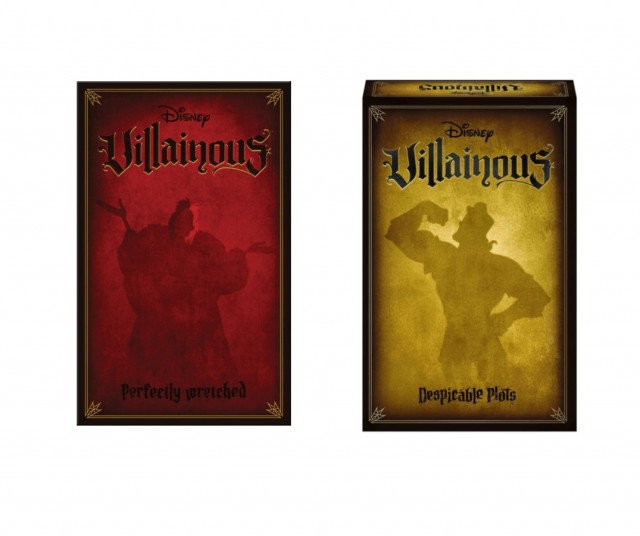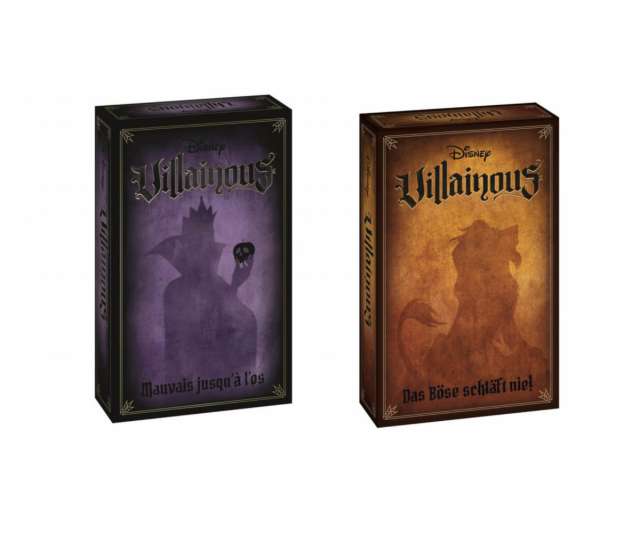Part I: The Others: Better than the others
An exploration of the seven Sins of The Others, their Acolytes, and the local Hell Club.
Each Sin has a group of minions comprised of six Abominations, one Controller, and one Avatar. All of the minions have the same stats (3/3, 4/4, and 7/7, respectively) so there’s no need to keep track of individual powers on the part of models. However, each Sin also has a special ability tied to its identity, as well as a deck of 12 cards, half of which are the same across all seven Sins, and the other half of which are unique to each one.
Of the common cards, the ones that have really stood out to me over the years have been: For Our Master, which draws you more cards; Evil Regroups, which lets you move monsters (always crucial, as we’ll see when we cover Wrath); and Hate!, which lets you push the Apocalypse Track forward and which the FAITH players often neglect by the end of the round. The rest are still useful but haven’t been as impactful in most of my plays as the Sins.

Envy: “Whenever a Hero gains an Upgrade card, they may take 1 Wound - otherwise, all other Heroes take 1 Corruption.”
This is one of the more complicated Sins to play, as you don’t have much impact until the Heroes begin gaining Upgrades, which will typically happen with City actions. If they want to avoid your effect, they can try to avoid said actions, but it will, of course, make things more difficult trying to run around Haven without any gear. Also, your ability does make the Heroes stronger in the short-term, so I’ve found the most success with Envy in Corruption scenarios, where the gaining of any Corruption is often pushing players toward some difficult times. In that case, they’re more likely to accept the wound, in which case they might become the more viable target for a pile-on from the nearest horde of creatures. But Envy is definitely one of the more subtle of the Sins (just like in life!) and is perhaps more suited to the experienced player.
However, Envy’s cards are quite strong, as this is a Sin that develops more from combo play. But knowing how to develop those combos is, again, generally the province of someone with a bit of experience in the game. Spiral of Desire, for example, can let you use an Acolyte ability for a second time in a fight involving your Controller. Having two heroes that can’t heal (Doctor) or that lose their Natural Ability (Diplomat) for the rest of the round could be devastating. Envy is also one of the Sins that can move the Avatar directly into combat with Jealousy Incarnate or can engage in group torture with From the Deep (Corruption) or Can’t Always Get… (Wounds.) And it must be said that Envy’s models are among the coolest in the game, with the spiky, serpent-dude Abominations standing out.
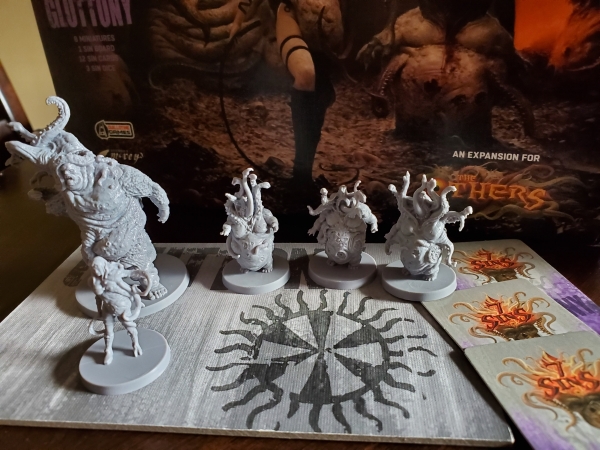
Gluttony: “Whenever a Hero gains an Upgrade card, you gain a Sin card. Whenever a Hero gains an Extra Turn token, you gain a Reaction token.”
Gluttony, OTOH, is just straight up exchange. They get, you get. It drastically increases the speed of your development and the FAITH players can find you breathing down their necks very quickly. That makes Gluttony really good in Redemption missions, since you’ll be able to more readily engage with extra Reaction tokens and make moving Innocents a lot more difficult. Indeed, Gluttony is one of the best Sins at targeting one hero and simply removing them from the game, based largely on a couple cards, but also because you can often simply move faster than with other Sins.
Devour the Self is one of those cards, since it allows you to ignore a hero’s base defense, which can be a huge advantage against Bruisers. Similarly, Poison Indulgence gives you extra dice for every Upgrade and Extra Turn token a target possesses. Ravenous Frenzy duplicates whatever bonuses they have on your Avatar. Since the Avatar is present so early in Redemption scenarios, you can have an increasingly powerful threat that can cleave through multiple heroes and secure the win almost singlehandedly. This Sin, more than any other, is the answer to any fears you might have about loot overwhelming the game, since it will enable greater access to your deck and these potential one-shot cards. Remember, though, that only one card can be played per turn. Having extra bodies with Gangsters or adding insult to injury with Hoboes also works well with this Sin. In contrast to Envy, these Abominations look more like a collection of small otyughs (Old school D&D reference) and are perhaps the least visually outstanding of any of the Sins; as is the Avatar, while the Controller manages to be somewhat more disturbing.
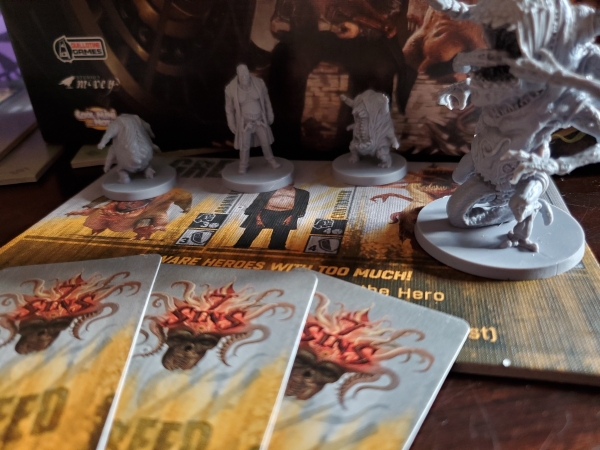
Greed: “You roll +1 die in any Fight with the Hero with the most Upgrade cards.” (Ties for most Upgrade cards count as the most.)”
This Sin is a bit more restrained, since you’ll generally be targeting one or two of the heroes at any given time. Also, since it’s +1 die, which could produce wounds or Corruption (or nothing), it makes Greed more of a general operator, which often means that the Terror scenarios are preferred. That said, Corruption scenarios offer potential because of the possible impact of the Dark Past cards, which might further highlight your target(s.)
Greed’s cards can have high impact, though, closely tied to the theme of the Sin. For example, Feeding Your Selfishness gives you a Sin card and a Reaction token for each Upgrade the current hero has. That’s a phenomenal burst of power in any given round. Covetousness moves a hero toward a district with the City action for Upgrades and draws you a card. Again, movement- and position-affecting cards/abilities can often have larger impact in the course of a game than initially believed. Primal Hunger, which destroys all of a hero’s Upgrades unless the heroes collectively take 3 wounds, is also a good test of group coordination. Still, I will say that Greed is one of the Sins that has, overall, been less memorable than the others. Its models, however, are a step up. While the Abominations are even smaller than Gluttony’s, their general Gibbering Mouther depiction (think mouth-in-the-chest moment from John Carpenter’s The Thing) is closer to the ideal of the kind of “transdimensional horror” theme that the whole game is based on. The Controller is a good stand-in for Hellraiser’s Butterball, too.

Lust: “If any Hero ends their turn in the same space as one other Hero, both Heroes take 1 Corruption.”
This Sin, OTOH, has been massive in my plays. Lust and its converse counterpart (Pride) have a background effect that forces the heroes to work harder and think more about what they’re doing and how they’re doing it. As with Envy, the drawback is that two of the heroes technically become more powerful when they ignore your effect. But coordinating group responses becomes more difficult when they have to consider the more rapidly mounting Corruption toll. This obviously makes Lust a good choice for Corruption scenarios, but the overall game impact of its ability makes it a good choice for any of the three types (or "Rise of the Hell Club.") Obviously, the way around making that choice is to have a group of three and then a solo player, but that puts the loner in real danger of being ganged up on, while it restricts the ability of the other three to cover the board.
Lust’s cards are also brilliant. Pheromone Dance lets you move each hero up to one space, which is enormous in its potential value. It can be canceled (by one hero paying two wounds), but it’s still a pretty stiff price (28% of total health) and which cancels out some of the power gain from the Corruption. Dark Attraction can stall a FAITH goal for an entire round by making monsters immune to attacks from lone heroes. And Feeding Off Lust can be a huge opportunity for a one-shot attack, especially if the lone attacking monster is the Avatar. Distracted by Desire also earns a mention, for not only impacting a key FAITH roll (-1 die) but also replacing itself (draws a card.) Also, the art design of the faction is top-notch; showing a great deal of symmetry between the Abominations and the Avatar, making the reference inherent to the Controller being dressed in a bishop’s miter rather pointed (softball…), and having a faction rune that’s, um, rather obvious but still restrained (Envy’s is also good for this, with the green eye of jealousy.)
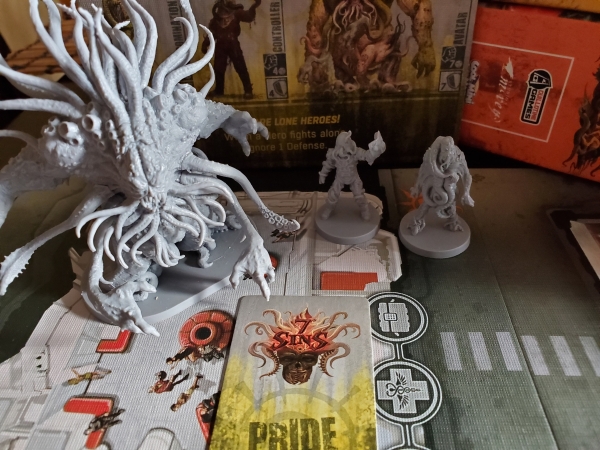
Pride: “When a Hero fights alone, ignore 1 Defense.”
As noted, Pride is the converse of Lust, in that heroes don’t want to be alone because of the deleterious effect on their survival. Most FAITH operatives don’t really want to be alone in the first place because of that risk, but it gets more problematic against Pride. -1 Defense doesn’t sound like a huge thing but, again, the fine margins of the game can make it enormous. There are a couple heroes I’ll be spotlighting in part three (Keep the FAITH) that would be (ahem) holy terrors if not for their subpar Defense (or, in one case, total absence.) This effect makes Pride a really good choice for Redemption scenarios, which often require more solo activity because of the need to transport Innocents. Similarly, the higher damage possibilities of Terror scenarios make the Pride effect shine a little darker.
Pride’s cards are a bit more situational than Lust’s, but can be just as devastating in their more narrowly-defined circumstances. Pride or Fear?, for example, teleports a hero two spaces away, which can be huge… but the Controller has to get a wound in. Primal Conceit lets you place the Avatar anywhere at the start of a fight, but each lone hero can take two Corruption to prevent it. But Alone in the Dark is unavoidable Corruption for a lone hero and gets you a Reaction token. So there are ways to make them work. They just don’t jump out at you in the same way as other Sins and I think that may have been part of the reason that Pride was included in the main box, since there are fewer “Gotcha!” moments in the cards, as long as the heroes learn quickly to stick together. The other reason is probably the models, since both the Controller and the Avatar stand out as particularly eye-catching; with the Controller hoisting aloft his Hellraiser box/Cosmic Cube (that’s probably how he teleports people away) and the Avatar being the image that most associate with the game: a massive array of tentacles who takes up about 1/12 of the box space on his own.

Sloth: “Heroes that Start a Fight are Marked until the end of the round. Marked Heroes move 1 fewer space per turn (minimum of 1.) A Hero may take 1 Wound to ignore this for a turn.”
Sloth is the fellow inhabitant of the main box and, like Lust, is among my favorite Sins to play, since his effect can be crucial in both forcing the heroes to really consider their targets and keep them short of (literally) reaching their goals if they don’t. Again, Sloth can be huge in Redemption scenarios but, like Lust, is really suitable in any of them, just because of how daunting its main effect can be. As always, in dungeon crawlers, where you can get to is often just as, if not more, important than what you can kill.
Sloth’s cards are excellent in that respect, as well. Curse of the Crawl means the current hero can’t move at all unless the team collectively takes three wounds. Punish the Idle means heroes take double damage for leaving a space with an Abomination for the whole round. Slouch in the Dark lets you move three monsters at the start of a hero turn. And Primal Lethargy is one of the ultimate “moment” cards, as it means that you and a hero involved in an Avatar fight both lose 2 dice. If one of their goals is to kill the Avatar and you’ve just made the game go another round, with another ‘tick’ on the Apocalypse Track… Sloth’s minis are great, too, as the symmetry between Abominations and Avatar is similar to Lust’s. The Aboms are much larger than Pride’s, too, giving more of that “huge, threatening monster” vibe for people who’ve picked up the base game. The Controller is kind of weird, though, given that he seems to be an “expose myself” trenchcoat guy, which doesn’t really fit the theme of Sloth.

Wrath: “Each time one or more Monsters are destroyed in a Fight, teleport ANY Monster 1 Space, unless the current Hero takes 1 Corruption.”
Wrath’s ability strikes most people as underwhelming, since you have to lose resources to make use of it. But you remember what I said about movement, right? Trust me. It’s amazing. Those resources you’re losing are ones you were going to lose, anyway, as the heroes will have to kill your minions to make progress on their goals, directly and incidentally. You also have a neverending supply of those resources and, every time you lose one, you can rearrange the battlefield in some fashion. That includes teleporting the Avatar if your players don’t feel like paying the 1 Corruption. I’ve had it happen, most memorably in a Corruption scenario ("The Darkness Within") where three people were about to max out and confront their Dark Past cards. If you think of your minions as recyclables, you’re well on your way to succeeding with Wrath.
Wrath’s cards are, likewise, kind of amazing. Abominable Wrath leaves behind a Fire or Corruption token for each Abomination killed in that fight (Recyclable!) Dying Wish lets you draw two cards or get two Reaction tokens when a monster is killed (Recyclable!) Pulling Strings lets you teleport the Controller into a fight by sacrificing another monster (Recyclable!) There are so many tricks you can pull with Wrath, it’s kind of surprising when you finally sit down to play with it. In contrast, I found the minis almost underwhelming. I expected a little less of the eerie/unnerving design of the others, but a bit more of the Hounds of Tindalos-style teeth-and-savagery. I got one but not the other.
Keep in mind that my scenario suggestions are very general, as all of the Sins work fine in their own ways in all of them. I think there are upsides and little quirks to be drawn from each of the Sins and have enjoyed playing them all, but my favorites are definitely Sloth, Wrath, and Lust.
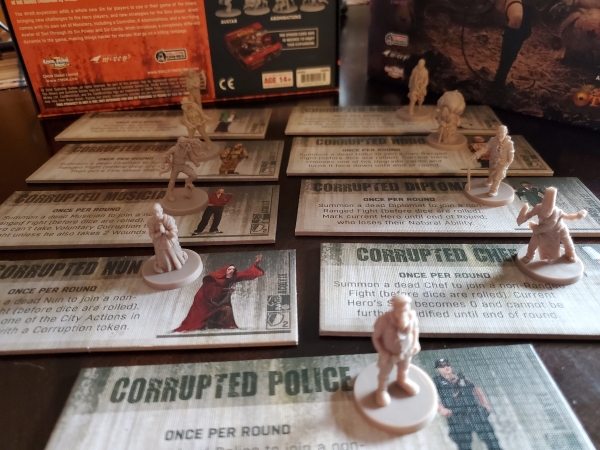
Acolytes:
I think all of the Acolytes can be useful. I think some are clearly more useful than others and will list them in the rough order in which I favor them. One thing to keep in mind is that at least one of them has to die in order to use their ability and that ability can only be executed once per round, so likely against one player. My heroes once tried a game that was predicated on not killing my Corrupted Musicians so that I couldn’t use their ability at all. It kinda worked, except that five Musicians in one space meant 10 dice of lousy beatniks beating on YOU, Ned Flanders. That can get tiresome.
Corrupted Doctor: King for a reason. They can teleport in and keep a hero from healing for an entire round. Yeah, that’s some good and especially good in Terror scenarios and the Sins that favor them (Lust, Pride, Wrath.) The good doctors can often have more impact than any other Acolyte.
Corrupted Hobo: There are those moments when someone has snagged a really good item and you’d like to put it on pause for a bit. Here’s your chance. It’s true that they’ll be able to pick their least favorite, but Upgrades often don’t come around for a bit in some games or don’t get spread around to everyone. They’re often best against Sins whose effects can be overcome with particular items (Sloth) or those that target Upgrades (Envy, Greed, Gluttony.)
Corrupted Fireman: Adding a free Fire token in a key spot, plus another body to attack with? Sure. Why not? Many FAITH players tend to undervalue their Fixers, so placing more obstacles that said team member is supposed to deal with will add up on the rest of them. Good with Sins who are favored in Redemption scenarios (moving through the fire is key), like Pride, Gluttony, and Sloth, but also good in Terror scenarios that often have even more Fire.
Corrupted Diplomat: The Diplomats are kind of a targeted Acolyte that you’d generally bring out against heroes that have a specifically powerful ability that takes place during or at the end of a turn. (It can’t be the start because there has to be a fight happening for the Diplomat to appear.) Many heroes have great continual abilities with lesser basic stats to compensate, so removing one for a turn can be crippling.
Corrupted Musician: The Musicians are a long-term Acolyte. They become very useful in the later game, where wounds are plentiful and the challenges are becoming more urgent so the desire to use Voluntary Corruption is that much greater. In that respect, they tend to function better with some of the slower, more card-driven Sins like Envy and Lust.
Corrupted Chef: Like Diplomats, Chefs are a targeted Acolyte but with an even narrower focus, in that they’ll mostly be used against Fixers and occasionally against Leaders, who are generally the ones tasked with cleaning up the stuff that isn’t moving and trying to eat you. That generally puts them in the category of Redemption-oriented Sins.
Corrupted Nun: Nuns can be a map-dependent Acolyte. If it’s obvious that your heroes have easy access to City actions and are going to take full advantage of them (which they should!), then the Nuns may be a good choice, especially if you’re trying to restrict access to healing in Terror scenarios, curing Corruption in those type scenarios, or keep your opponents away from gear. One real upside is that the Corruption has to be removed like any other token for the action to be used again.
Corrupted Police: Adding a Wound along with the arrival of a 2/2 body isn’t necessarily a bad thing, especially in scenarios with high damage potential, like Terrors, or against sins that can really dish it out, like Pride. Every wound IS almost 15% of a hero’s health. However, compared to the others, the cops are a bit mundane.
Corrupted Gangsters: Similarly, the Gangsters leave a bit to be desired. Don’t get me wrong: having more bodies is having more bodies, as I mentioned in my Musician example above. But adding in an extra 2/2 once per round is a bit less exciting than what the others can produce, on top of their single 2/2.

The Hell Club:
The Hell Club is an interesting sideshow in the game, One of the more enticing aspects of The Others to me is that it’s a dungeon crawl without campaign trappings, but which still has a ton of story behind it. The Hell Club brings us a bit closer to that campaign-based approach and I’ve never been quite certain about that. Since they’re all part of a random draw in the Apocalypse deck, you never know whether Grin or Marguerite or any of them will show up in the first place. When they do appear, it can be a really daunting task for your heroes or it can be another speed bump on their way to try to kill the Avatar. And, once they’re dead, they’re dead, so the prospect of having a cool story to tell about the fight with Dr. Gan is completely random and, unfortunately, rare in my experience. That is, of course, different in the "Rise of the Hell Club" scenario, where they’re the stars of the show.
Dr. Gan: The Pinhead stand-in, Dr. Gan in Immolated form can be a decent opponent (5/5) but not overwhelming in a Terror scenario. In Soulbender form, though, Gan can be vicious if the hero is low enough in health to make sacrificing an Innocent a real consideration.
Flay: The least seen of the club, since she has only one form (Pain-Daughter), Flay can actually be a considerable threat, dealing 6 damage against heroes who will almost certainly be corrupted enough to get the full experience.
Gourd and Hex: The little guys in Hatespawn form can be one of the more annoying elements of a Corruption scenario, since heroes will frequently be unable to touch them. However, at only 2 attack, they’re far from life-threatening alone. However, in Demonspawn form, they give the Sin player a tougher minion (3/3) and allow them to use the Acolyte ability twice, which can be huge.
Grin: Like Flay, the big guy in Demolisher form can be a considerable threat at 6 power, although it’s more difficult to maintain him that way. However, in Fist form, automatically doling out a wound before any dice are rolled will generally be more of an advantage, even if he might not last long after the fight starts.
Marguerite: In Fire Queen form, she’s probably my favorite. Dropping Fire tokens in almost every fight can get deadly right quick. Similarly, in Soul-Blighter form, Marguerite can be sprinting across the board on a regular basis, since she moves when anything else moves.
Put simply, in Terror scenarios, you want Marguerite. In Corruption scenarios, you also want Marguerite. In Redemption scenarios, you want Gourd and Hex. But you get any of them for free, just for drawing a card, so there’s rarely anything to complain about.

A few words about Nicolas and the Mayor:
These two minis (and associated cards) come with the Omega Team box. They can be added to the Apocalypse deck if your heroes need an additional challenge (Ha!) I’ve used them sparingly because they can be extremely powerful in the right circumstances (the Mayor) or pretty much all the time (Nicolas.)
Nicolas: In Rises From The Flame form, he takes two crucial NPC tokens (Ravenscorp, Commissioner) in Terror scenarios and makes them Abominations. That’s, uh, some good, especially since they’ll drop out of a hero’s possession as soon as Nicolas arrives. In Descends From The Heavens form, he speeds up the clock on people escorting Innocents, which makes it tougher, but not overwhelming. In Twilight Prodigy form, he makes it more difficult for heroes to use City actions, which can have a huge impact, but is often situational.
The Mayor: In Seals The Deal form, he’s a walking firestarter, which basically just carries the theme of Terror scenarios. In Pulls Strings From Below form, he inhibits City actions. Combining him in this form with Corrupted Nuns can be quite the combo. In Exposes All Secrets form, he can be a serious threat to the heroes, but is still just a 3/3. However, since the Mayor automatically returns to the board in all three forms, that’s a 3/3 recurring nightmare, which makes him much more of a threat than he would at first appear.
So, that’s the trip through the bad guys. Hopefully, this will give Sin players some cues on how to torture their FAITHful heroes, whom we’ll talk about at length in part three, along with some closing thoughts.
 Games
Games How to resolve AdBlock issue?
How to resolve AdBlock issue? 